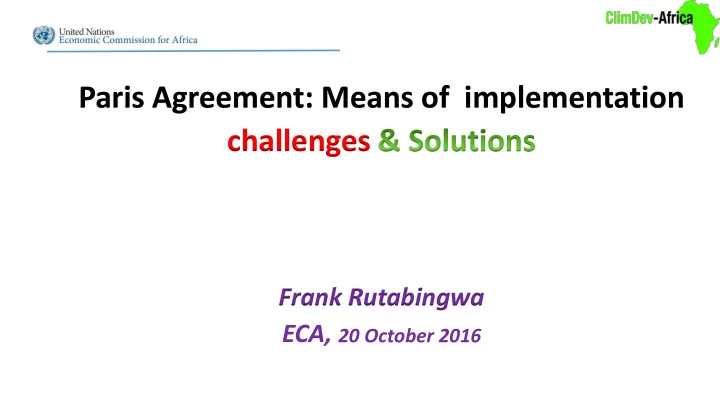

Paris Agreement: Means of implementation challenges Frank Rutabingwa ECA, 20 October 2016
Content: 1. The Paris Agreement 2. Key features of Africa’s (I)NDC 3. (I)NDC implementation challenges 4. Need for developing & enhancing capacity 5. Building partnerships
1. The Paris Agreement promises to… • limit global warming to below 2 o C and move towards 1.5 o C, • increase ability to adapt and foster resilience, • avail adequate finance consistent with low carbon path and climate resilient development. https://www.google.com.et/search?q=paris+agreement&safe=strict&espv=2&biw=1920&bih=98 6&source=lnms&tbm=isch&sa=X&ved=0ahUKEwjVpJrA8eHPAhWBCCwKHYMQCiQQ_AUIBigB#im grc=48oc-jJn6v0mqM%3A
2025 2025 Review of finance December 2015 adequacy and avail Agreement reached additional funding 2023 April 2016 Key Milestones Begin stock-taking of Signing of PA by 191 of the Paris NDC and will be done countries every 5 years Agreement 2020 October 2016 Communicate NDCs & long-term emission Ratification of PA by strategies 97 countries 2018 4 Nov. 2016 PA enters into Review of INDCs 2017 force Adaptation review under UNFCCC
2: Key feature of submitted INDCs • involves both mitigation and adaptation actions, • commits LULUCF sectors as both source and sink, • comprises both non-conditional and conditional initiatives, • to date, – 37 signatories, – 16 countries are parties to PA, – 1 not involved;
Mostly not… providing cost estimates for achieving their adaptation and mitigation goals, identifying sources of funding (conditional, unconditional, private sector, and/or public) for both mitigation and adaptation, having UP TO DATE national GHGs emissions records despite pledged emission reduction commitments, coherent with national development plans and strategies, country driven. Hence the need for INDC revision before final submission as NDCs
3: (I)NDC Implementation Challenges low level of economic development, inability to leverage finance from various sources (international public & private finance due to inability to translate NDCs into bankable projects), limited human resource capacity and technical knowhow, governance challenges (political will, short term planning nature), lack of appropriate technology and own finance. The PA recognizes the above shortcomings, it calls for developed Parties to enhance the capacity and ability of developing nations
4. Need for developing & enhancing capacity of Africa CAPACITY-BUILDING is required at individual, institutional, organizational and country levels to: • enable parties refine their INDCs for effective implementations; • Revise and align national policies with INDC commitments; • identify, plan and implement appropriate action to adapt and mitigate climate change; • develop and strengthen skills and knowledge of human resources; • enhance technical capability to measure, assess and report GHG emissions; • Enhance capacity to translate NDCs into bankable projects and leverage public and private finance , etc.
Capacity-building should (be): • country-driven, based on and responsive to national needs, • foster country ownership of Parties, in particular, for developing country Parties, including at the national, subnational and local levels. • guided by lessons learned, including those from capacity-building activities under the Convention, and • an effective, iterative process that is participatory, cross-cutting and gender-responsive.
Under art.11; CAPACITY-BUILDING should enhance the capacity and ability of developing country Parties by facilitating/ implementing (art.11….… • adaptation and mitigation actions, • technology development, dissemination and deployment, • access to climate finance, • relevant aspects of education, training and public awareness, and • the transparent, timely and accurate communication of information”
5. Building partnerships Cooperation and partnerships at all levels; institutional, national, regional, bilateral and multilateral levels key in: • establishing appropriate institutional arrangements, • availing finance and ease of access to funding, • cooperating in innovation, technology development & access, • developing investment plans, bankable projects and leveraging private sector funding, • increasing R&D funding, to raise awareness & knowledge (mitigation required and adaptation responsive actions needed to build resilience); • developing domestic fund mobilization frameworks, • increasing political engagement and stakeholders’ participation to ensure national ownership.
Recommend
More recommend